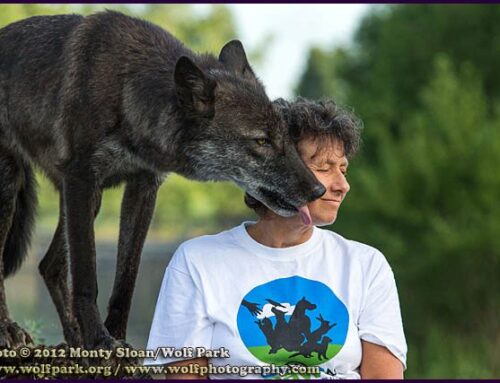We want our scared dogs to be comfortable with the things that frighten them. Counter conditioning and desensitization are all about making that happen. But we don’t just want them comfortable with the things that frighten them, we want them to be perfectly giddy with joy about them. Until that happens they are at risk of becoming aggressive. Don’t think that because a dog has not bitten anyone or anything, that it won’t at some time in the future. When people ask me if my scared dog bites I usually respond by saying, “He does have teeth.” And the reality for many scared dogs is that they may never be giddy with joy about the things that scare them, despite our best efforts.
My scared dog’s first and preferred reaction when faced with people is to flee. It’s a response that makes a lot of sense and ultimately is a win/win situation unless the person he’s fleeing from is trying to get a hold of him (namely me). My dog gets to move away from what scares him and the person doesn’t get bit. If I take away his option to flee, my dog typically shuts down, except if he’s aroused.
When we get scared enough our hearts start racing and the faster they race the less ability we have to make well thought out decisions. Our actions become controlled by different parts of our brain. The same is true for dogs. Research has shown that at that point our actions are more likely to be based on what we’ve practiced in the past and what our beliefs are regarding the options we have. It’s the major downside of racial profiling. Teach law enforcement personnel that a certain type of person is likely to be dangerous compared to another type of person and when forced to make split second decisions the person who looks like the one that fits the description of ‘more dangerous’ stands a better chance of getting shot than the one who doesn’t. What is tragically played out all too often is that the person shot was not a threat at all. It also happens that we are more likely to behave aggressively when we reach a certain point of arousal, even if the situation does not warrant it. Think about this in regard to the stereotypes your dog has regarding the things he’s afraid of. Some dogs are very specific in regard to who and what they believe to be ‘most dangerous’.
In our efforts to help our dogs become more comfortable around people or other dogs we decrease the distance between them, which decreases the amount of time a dog has to make a decision as to how to react. This is not a problem unless the dog becomes so aroused that it switches into reaction mode. At that point you want the dog to have practiced a behavior that is going to be safe for everyone involved and the simplest is ‘move away’. Practicing this behavior repeatedly when a dog is not afraid is important. Athletes practice a move over and over again until they can perform it well without thinking, especially when under pressure. Musicians and actors do the same thing. Helping your dog practice moving away from what scares it makes it more likely that you’ll get that response when the dog has to make a snap judgment about what to do when he’s afraid.





